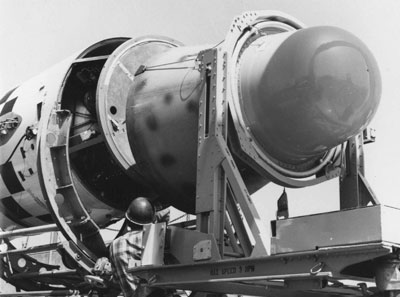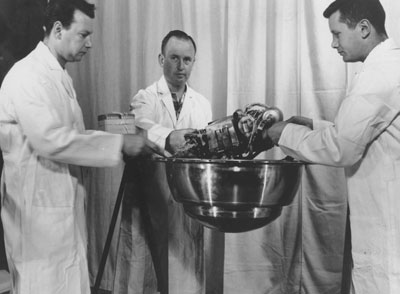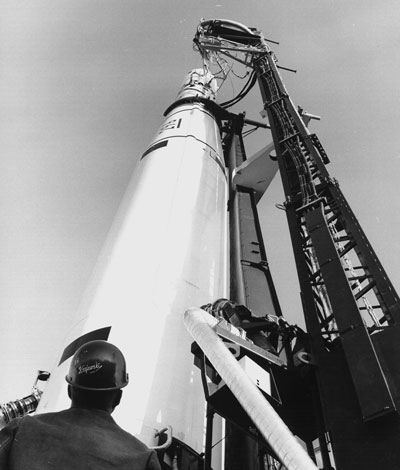Has anybody seen our satellite?by Dwayne A. Day
|
| “So it’s gone. And so all we can do is sit there and say, Where is this thing gonna come down?” |
This test, dubbed “Early Time,” went better than the last one. After a three-hour hold due to fog, the Thor lifted off and worked fine. The Hustler worked fine. The spacecraft reached orbit and began transmitting. Things were looking good. However, the orbit was a little off. It was not what had been planned. When the spacecraft emerged over the North Pole, the tracking station in Alaska noticed that it was not the planned orbit. Ground controllers relayed this data to the tracking station in Hawaii, at Kaena Point on the big island of Oahu.
It was up to a controller at the tracking station in Hawaii to send a signal to the Hustler. This signal would tell the event timer when to start its reentry sequence. It did this by telling the timer to advance the control tape—a long piece of plastic tape with holes in it—a certain number of steps to the point where the holes were punched that initiated the reentry sequence. “There was one little issue command that had to be given to actually cause recovery,” Jim Plummer explained years later. Plummer was the program manager at Lockheed in charge of the overall project. “And this was put in there because the orders that we got said the most important thing is to not lose the security of the program. The worst thing that could happen to us would be to drop something in Russia. Everything had to be under man’s control.” So as the satellite came down over the North Pole toward Hawaii, the tracking station pointed its antenna in the proper direction and sent a signal that advanced the “D” timer to the spot where it would initiate the recovery sequence.
But somebody goofed.
 The Discoverer 2 Satellite Recovery Vehicle being mated to its Agena upper stage and Thor rocket at the launch site in early 1959. (credit: USAF) |
“The tracking station lost count of how many steps that they actually had sent,” Frank Buzard explained. Buzard was in charge of the launch program and had a virtually encyclopedic memory of every failure that happened with the early launches. “And they were supposed to set some steps to move it from place A to something different.” Instead of telling the satellite to start the reentry sequence a few minutes away, so that it would reenter on the next pass, the improper command told it to start the reentry sequence a much longer time away. “And we could never talk to the bird again,” Buzard explained, “because once it went over the tracking station, it disappeared and we didn't see it again for 12 hours.” It would take that long before the satellite passed in range of another tracking station. And, of course, it would reenter long before that happened. “So it’s gone. And so all we can do is sit there and say, Where is this thing gonna come down?”
Everyone started poring over the vehicle specifications and the data very carefully, trying to figure out exactly what the incorrect commands would do to the vehicle and where it would come down. They performed their calculations and concluded that the re-entry sequence would start on the other side of the globe and the vehicle would land in the arctic north. They got out a map and drew the “footprint”—the area in which the SRV would likely fall. And the footprint intersected Spitsbergen Island.
Spitsbergen Island is north of Norway, in the Arctic Circle. When Air Force officials looked at the map, they realized that it was pretty darned close to the Soviet Union too. What was worse was that the Soviet Union had a lease to operate several mining facilities on the island and to fish in the surrounding waters. Very soon the Discoverer 2 vehicle would land amidst a bunch of Soviet miners and fishermen.
This was when Colonel Moose Mathison sprang into action.
Mathison was Vice Commander of the 6594th Test Wing, which operated the ground station and control facilities for the Air Force satellite programs. He had earned his nickname by charging into everything he did. Everybody who met him thought that the nickname was appropriate. He flew in civilian clothes by commercial airline to Norway. There he enlisted the aid of Major General Tufte Johnsen of the Norwegian Air Force Northern Command. They then set out in another plane for Spitsbergen.
“Through a lotta talking on telephones and the like, we got contact with two guys in Longeerben City, in Spitzbergen.” Buzard remembered. “And we told them to look out over the mountains at a particular time, and tell us if you see something coming down. And we described the parachute and the capsule on the bottom. So after the event was supposed to happen, the guy called these guys, and they said, Yeah, we saw it. Now, whether they actually saw it or not, I don’t know. They said they did.”
Mathison and his Norwegian colleague flew back and forth over the island. They could not land because Spitsbergen lacked an airfield. “So they flew over, and they saw a lot of tracks in the snow. And they said, Aw, that must’ve been the Russians gettin’ the capsule,” Buzard said. There were also rumors that a Russian fishing trawler had suddenly left port soon after the satellite reportedly came down.
On April 22 the Air Force terminated its search and declared the capsule lost. General Nathan F. Twining, the Chairman of the Joint Chiefs of Staff, wrote a letter to the Deputy Secretary of Defense and declared that there was a good chance that the Soviets had retrieved the capsule. He also suggested a possible diplomatic approach to the Soviet Union requesting a return of the capsule.
 The payload for the Discoverer 2 being placed inside the Satellite Recovery Vehicle. USAF officials suspected that this payload fell in Soviet hands. (credit: USAF) |
No overture to the Soviets was apparently made. Even if they had recovered the capsule it was doubtful that they could have learned much. The ablative reentry shield would have been jettisoned and likely fallen to sea. The recovery bucket had already been publicly displayed and so its size was no secret. The Russians could have measured the capsule’s internal volume and guessed at how much material—such as film—it could have carried. But there were many other factors that determined how much film could fly on a spacecraft, including the size of the spacecraft and the camera and the payload capability of the rocket. The Thor was awfully small. The Americans were not even sure that they could lift a camera and a full load of film into orbit. The Soviets might determine that Discoverer was just a test program and nothing else.
| The incident later served as the basis for Alistair MacLean’s 1963 book Ice Station Zebra, and the 1968 movie of the same name. |
Frank Buzard initially thought that the Russians probably obtained the capsule. But eventually he started to doubt this. It was unlikely that the spacecraft would have landed on the one spot of dry land in a big ocean. He concluded that it probably came down in the water and sank—or never even came down at all. There was no physical evidence on the ground indicating that the capsule had landed and Buzard learned to distrust the testimony of “witnesses” who were told what to look for. As for the fishing trawler? “That same trawler could have suddenly left port on schedule every Saturday afternoon,” Buzard explained.
But the whole episode highlighted the dangers of what could happen if they were not diligent. If the satellite had been carrying film and had fallen in Soviet hands that would have been a bad thing. Even President Eisenhower worried about this. “So we changed the clock after that one, so that we couldn’t make that mistake,” Buzard said.
The incident with Discoverer 2 possibly coming down on Spitsbergen and the US military scrambling to locate it was widely reported in the press at the time. It later served as the basis for Alistair MacLean’s 1963 book Ice Station Zebra, and the 1968 movie of the same name.
Today, almost exactly fifty years after the events of Discoverer 2, it seems highly unlikely that the Soviet Union ever recovered the capsule. Although Russian officials have revealed other Cold War intelligence coups against the United States and occasionally sold their stories for profit, nobody has claimed that they recovered this American spacecraft. Discoverer 2 is probably currently sitting on the bottom of the cold arctic sea.
